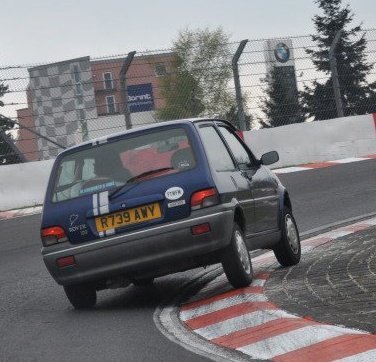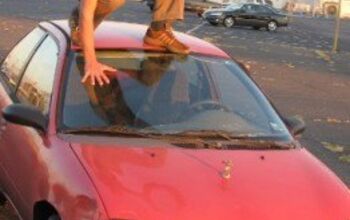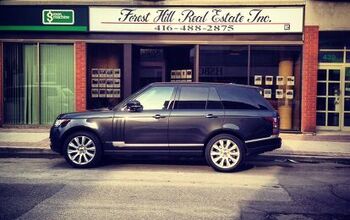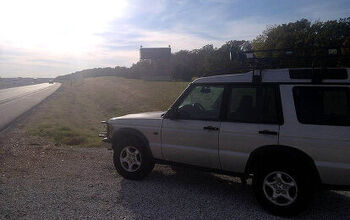Capsule Review: 1997 Rover Metro

No story should ever start, as this one does, with “my First Rover Metro.” The implication that there are more Metros to come is all too obvious, and could probably be best categorized as a “cry for help.” In any case, my first Rover Metro was a teal 1995 1.1L Kensington edition, purchased for £60 from a friend in Bishop-Stortford. The Kensington edition meant I got shards of carpet over the door panels, and the kind of pizzazz that only an engineer from Coventry would be able to come up with. The Metro lasted only 19 hours in my hands before a brake failure led to its demise into the back of a yellow Hyundai. My second Rover Metro was a 1997 Tahiti Blue 1.1L Ascot edition*, which meant I got full wheel covers and blue piping in the velour. This only accelerated my descent into the world of English motoring, where I found joy and fulfillment in the death rattle of a Rover K-series engine.
*astute readers will recall that both vehicles are technically Rover 100’s, but are always remembered in pop culture as the Metro.
The Austin miniMetro debuted in 1980 as a vehicle “to take on the world” as explained in the television adverts which swelled with British national pride. With an A-series engine from the original Mini, a hydrogas suspension, Applejack Green paint, the miniMetro stood poised for superstardom. Britishconsumers seemed to agree initially, as the first couple years saw records sales. Yet like most things emerging from the behemoth that was British Leyland, the miniMetro ultimately suffered from the “ambitious, but rubbish” mantra pervading everything from Morris to Triumph.
The rust monster ate the front wings, head gaskets failed, and the hydrogas suspensions left miniMetros leaning to one side like a drunken Austin Princesses. Sales fell at alarming rates, and Metros became rolling jokes relegated to the retiree and poor student population. Grafting a Rover badge onto the front, dropping in the new K-series motor, and the “After all, it’s a Rover” campaign failed to bolster the tarnished image. Yet for 17 years, the British kept buying the things. I wish I could fail to understand this pattern of behavior, but I know it all too well, as being American, we bought the equally ambitious but rubbish Cavalier for far longer.
My Metro odyssey really began as my brother and I were left stranded in East Anglia during the ides of fall with a smashed Metro Kensington. We were on our way to a dinner party (or drinking fest, whichever) at the Coach and Horses Pub in Sheffield. Several phone calls to friends and a tow truck ride later, we were on the British Rail system headed north. The next two days in Sheffield became a whirlwind of surreal as me and my British mates decided purchasing a vehicle for less than £500 (or the cost of an airplane ticket to Frankfurt) was really the only solution to my predicament. We surveyed a white Rover 420d, but the blowing exhaust, knackered CV joints, and dodgy Hungarian owner put us off. We quickly ruled out a Proton, really shady BMW 318i, and a really nice Mercedes-Benz E300 owned by Ivy Tyldesly of Coronation Street. The Merc proved doomed when the heater failed to work, a requirement with the European winter approaching.
I nearly gave up hope, until a quick search in the classifieds turned up a 1997 Rover 100 Ascot, for £400, one-owner, 30K miles, and a long MOT and tax. The dealer was even driving it into Sheffield from Doncaster. Knowing when fate slaps you in the face, I couldn’t resist.
As I discovered, the Metro proved much better than my English friends had led me to believe. Acceleration was perfectly adequate, the ride was smooth, the transmission was fine, and the brakes were beyond scary. Hard plastics abounded, gaps were everywhere, yet the plush velour seats were very comfortable, which helped given the most awkward driving position this side of a double decker bus.
Yet shod with Pirelli P-Zero Corsa tires, the blue “Metro of Win” became a permanent fixture in the parking lot below the castle of Nurburg, waiting to pounce on unsuspecting Porsches and BMWs, pulling in a very frightening Bridge to Gantry time of around 11 minutes. The Metro took untold dozens of passengers around the Nurburgring at insane speeds of 110mph down hill, and at full suspension compression in nearly every turn, demonstrating the fact that knowledge, not horsepower, wins the day in the Green Hell.
The residents of Nurburg held a moment of silence when rust and electrical gremlins finally claimed its little life. Yet, it lives on, as the engine parts were salvaged to save a stricken mk1 Lotus Elise that broke down.
The Metros are hateful little cars, full of bad design, yet, they come together as whole that so rarely comes to light in the modern era. The Metro is a true metaphor of the culture that built it. Ambitious, but rubbish, but oh what cheap, joyful fun to be had.

More by Mike Solowiow
Latest Car Reviews
Read moreLatest Product Reviews
Read moreRecent Comments
- Pig_Iron I one of those weirdos who liked these.
- SCE to AUX Inflation adjusted $79k today (!), so I guess $28k is a bargain....This is another retro car that was trying too hard, but it is very nice.
- EngineerfromBaja_1990 It might provide an edge in city driving but from what I've read elsewhere the Hybrid trucks are 600 lbs to 700 lbs heavier than the gas only trucks. That translates to a curb weight of around 5000 lbs which is not uncommon for a full size truck.And a test drive suggested the Hybrid is not quicker than the gas only trucks. So it looks like the Hybrid powertrain is pretty much compensating in power for all that added weight while not providing significant fuel savings. Not what many would expect after shelling out an extra $5K - $7K for the next step up in power.
- Buickman DOA like no other!
- 3-On-The-Tree Yes anything offroad or high performance isn’t cheap. My oldest son would do occasional burnouts in his Mustang GT then he had to buy tires for it. Needless to say he doesn’t do burnouts anymore.






































Comments
Join the conversation
Folks, this was a car that was actually launched in the late 70's and survived with light facelifts into the late 90's.... It was about 20 years old when it went out of production. Blasting it on safety is deeply unfair because it was only designed for 70's crash regs. It's not the cars fault Rover group couldn't afford to replace it. In many respects you should praise it for rescuing the British car industry. As a car it was a stupendous success.
I never sampled the joys of the Rover 100 but my first experience of British driving was in rented Austin Metro in 1986. This was probably a better time for the Metro since it was still a relatively recent design and ours was almost brand new,plus we came to it after a day in a Hyundai Pony. The flying turd (it was brown, very brown) was the then newish 4 door in near basic City X trim with a 1275 A series and managed to blast around around various back roads better than either of our regular rides ( Volvo 164 and US built VW Rabbit) could have so overall my impression was positive.